Benin Photography Tour Report 2023
17 February 2023







































































































































Our first encounter with Egunguns was in a small town (image by Inger Vandyke)

Looking after her twin babies, a Vodunsi woman sits watching her counterparts in a ceremony (image by Inger Vandyke)

Portrait of a beautiful Fulani medicine woman from Niger (image by Inger Vandyke)

Brightly painted wooden fishing pirogues adorn the beaches near Cotonou (image by Inger Vandyke)

A Taneka lady with her dramatic scarification, connecting her to her culture (image by Inger Vandyke)

Detail of Egungun dancer hands holding an Asosi made from horse hair (image by Inger Vandyke)

Portrait of a Dikpantri dancer. His white beard fashioned out of animal fur signifies he is passing from warrior to elder (image by Inger Vandyke)

A pair of Batonu horsemen kiss as they race their horses through the street (image by Inger Vandyke)

Miss Benin at the annual voodoo festival! (image by Inger Vandyke)

A scarred male Vodunsi groom in remote Benin (image by Inger Vandyke)

Trance is one of the harder concepts to grasp as a non-follower of Voodoo. It is often used to get ceremonial dancers into the swing of performing at a ceremony (image by Inger Vandyke)

A resident of Ganvié watches as we cruise past his home in wooden pirogues (image by Inger Vandyke)

The vibrant dance of Waaba women (image by Inger Vandyke)

Zangbetos are adorned with a wide variety of things including monkey skulls, horns, shells and feathers (image by Inger Vandyke)

A Koku adherent pays homage to the spirits at a legba (image by Inger Vandyke)

Young Fulani girls watch our group from the motorcycle owned by their head man (image by Inger Vandyke)

The old quarter of Porto Novo directly surrounds its historic mosque and has some fantastic shops (image by Inger Vandyke)

A typical 'street' scene of Ganvié (image by Inger Vandyke)

In the women's compound of King Agassa we experienced our first encounter with twins, learning of their importance in Beninese culture (image by Inger Vandyke)

Detail of a decorated horse (image by Inger Vandyke)

Koku dancers twirl into our private ceremony (image by Inger Vandyke)

Stunning Otamari scarification is very fine and elegant (image by Inger Vandyke)

A female Koku dancer twirling in front of the Legba devoted to Koku spirits. A Legba is like a shrine for offerings to certain gods (image by Inger Vandyke)
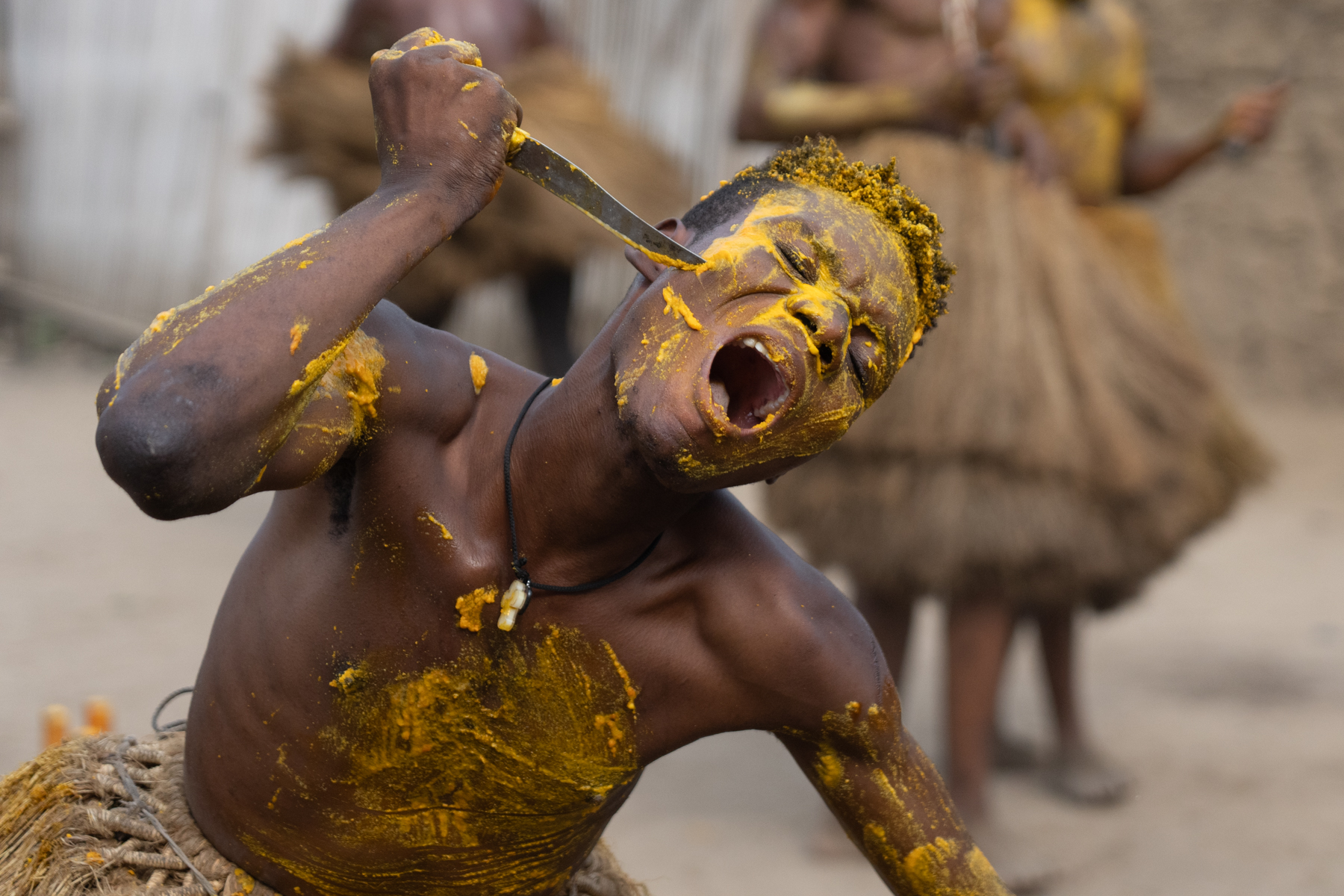
Simulated cutting at a private Koku ceremony (image by Inger Vandyke)

The colourful great mosque in Porto Novo is almost a hundred years old (image by Inger Vandyke)

Portrait of a beautiful Fulani woman with her intricate facial tattoos (image by Inger Vandyke)

Brightly coloured sailing boats on Lake Nokué (image by Inger Vandyke)

Guèlèdè fire spitter. What a fantastic and wild thing to see! (image by Inger Vandyke)

A group of Otamari children carrying water in the Atacora mountains of northern Benin (image by Inger Vandyke)

Wooden canoes moored up in the queue to get fresh drinking water at Ganvié (image by Inger Vandyke)

A giggling father and son in a village of Vodunsi (image by Inger Vandyke)

The wild riding and dancing of horses by the Batonu horsemen of Benin (image by Inger Vandyke)

The brightly coloured fish market at the edge of Lake Nokué (image by Inger Vandyke)

The women of King Agassa's compound include his wives, their families and his own family members (image by Inger Vandyke)

Exploring street art with the locals in Cotonou (image by Inger Vandyke)

A Gambada dancer in trance (image by Inger Vandyke)

A group of Otamari men arrive to celebrate Dikpantri, or initiation of young warriors to elder status (image by Inger Vandyke)

Before terrorising the local Tofinu kids an Egungun twirls to prepare for the chase in Ganvié (image by Inger Vandyke)

Voodoo is sometimes described as 'he who belongs to the sea'. Two voodoo adepts watch the ocean at the conclusion of the festival (image by Inger Vandyke)

The elaborate scarification of a Holi man (image by Inger Vandyke)

A group of Holi women preparing food over an open fire in their village (image by Inger Vandyke)

A Vodunsi with her twins in remote Benin (image by Inger Vandyke)

A Sakpata dancer enters the ceremony carrying a sacrificial chicken in his mouth! (image by Inger Vandyke)

Portrait of a Fulani horseman in Benin (image by Inger Vandyke)

A beautiful young Vodunsi sings at a ceremony to welcome us in remote Benin (image by Inger Vandyke)

Egungun feet. Each Egungun has a costume uniquely designed for them so the detail in each is stunning (image by Inger Vandyke)

Portrait of a Koku dancer covered in kaolin and yellow palm oil, the trademarks of Koku celebrations (image by Inger Vandyke)

Our second encounter with Egunguns surprised us at Ganvié (image by Inger Vandyke)

One of the endangered coastal fishing villages in Benin. These are rapidly disappearing in the face of modernisation and development (image by Inger Vandyke)

Portrait of a pretty Beninese girl we met before our beach dinner in Cotonou (image by Inger Vandyke)

A Gambada dancer takes a break between energetic bursts of dancing at the ceremony of love (image by Inger Vandyke)

A Guèlèdè dancer reaches into his flaming bowl to grab live embers which he threw on the ground near our feet! (image by Inger Vandyke)

In Vodunsi tradition the future brides wear white and cover themselves in kaolin powder 'to feed the spirits' (image by Inger Vandyke)

An Egungun dancing at a private ceremony of our tour (image by Inger Vandyke)

Dikpantri dancers in northern Benin (image by Inger Vandyke)

A Koku master of ceremonies brings a skirt into the arena to prepare for the Koku display (image by Inger Vandyke)

A line up of masks in the courtyard of a Guèlèdè mask carver (image by Inger Vandyke)

Street view of a Guèlèdè dancer with a curious local child (image by Inger Vandyke)

While still being renovated we managed a brief visit to the Portal of No Return, the key slavery monument of Ouidah (image by Inger Vandyke)

A group of Otamari women sit outside an ancient Tata house with their gigantic drums made from gourds (image by Inger Vandyke)

Local West African fabric depicting the various ceremonies of voodoo (image by Inger Vandyke)

Egunguns traditionally emerge from a sacred forest or their temple (image by Inger Vandyke)

A Gambada statue smoking a cigarette (image by Inger Vandyke)

As Koku dancers approach the arena, they stop at a centrepiece to cover themselves in kaolin and palm oil (image by Inger Vandyke)


The hand sculpted Tata houses of the Otamari people in Benin and Togo are some of the finest examples of African vernacular architecture on the continent (image by Inger Vandyke)

An elderly lady at home in a remote fishing village on the border of Benin and Nigeria (image by Inger Vandyke)

A running Egungun masked dancer (image by Inger Vandyke)

One of the most highly decorated Otamari head men in Benin (image by Inger Vandyke)

The simple yet melodic finger bell used by Otamari people to make music at ceremonies (image by Inger Vandyke)

Egungun dancers at the start of our private ceremony (image by Inger Vandyke)

Sequins and patchwork adorn an Egungun dress (image by Inger Vandyke)

Young girls peer at us from lines of nets in a remote fishing village near the Nigerian border of Benin (image by Inger Vandyke)

Koku at the annual Voodoo Festival (image by Inger Vandyke)

Portrait of a beautiful tattooed Fulani lady in northern Benin (image by Inger Vandyke)

A Shango priest sits beside the main shrine of the Shango temple (image by Inger Vandyke)

Detail of the ancient practice of tattooing in Holi people. This has largely been abandoned now and only elders of the Holi people carry these beautiful marks (image by Inger Vandyke)

Beads flying as a Sakpata dancer lands after a somersault (image by Inger Vandyke)

Detail of the palm oil preparation at Koku (image by Inger Vandyke)

Young girls line up to perform Atigali, another voodoo ceremony of healing (image by Inger Vandyke)

A local Holi man constructing the roof of his new home (image by Inger Vandyke)

Portrait of a young Batonu horserider on his horse (image by Inger Vandyke)

King Agassa, the highest figure of voodoo in the world, stands at the entrance of his home before we are granted a private audience with him (image by Inger Vandyke)

A young Batonu horse rider who is growing up in the terrific tradition of his father (image by Inger Vandyke)

Borgu Fulanis choose the colour of royal blue as their traditional dress. Here a group of young Fulani girls hold hands in friendship against a backdrop of their pretty dresses (image by Inger Vandyke)

A priestess summons the earthly Sakpata gods to heal someone of illness (image by Inger Vandyke)

One of the Holi elders prepares to greet us and welcome us to his village (image by Inger Vandyke)

A Taneka matriarch overseas the arrival of attendees at a funeral (image by Inger Vandyke)

Wandering the labyrinth of alleyways between Taneka compounds is a wonderful way to meet the spiritual healers that call the community home (image by Inger Vandyke)

A pretty Holi girl sitting in the granary that is used to both store grain and dry washing! (image by Inger Vandyke)

A beautiful young Fulani girl in remote Benin (image by Inger Vandyke)

Portrait of a charismatic Tofinu fisherman near Ganvié (image by Inger Vandyke)

Although the city is rapidly being developed there is still no potable water in Ganvié, so its residents must fetch water to their homes by canoe from a central pumping station (image by Inger Vandyke)

A Taneka spiritual healer of fertility sits outside his home smoking a long pipe (image by Inger Vandyke)

When we first met Egunguns we found two in a small town so we photographed them at the workshop of a nearby blacksmith (image by Inger Vandyke)

The dancers of Sakpata twirl and somersault energetically during the ceremony (image by Inger Vandyke)

A Batonu rider and his horse (image by Inger Vandyke)

A group of Fulani women walking the roads of Benin to sell traditional medicines (image by Inger Vandyke)

Portrait of the key handler at Benin's temple of pythons in Ouidah (image by Inger Vandyke)

Portrait of a Shango priest (image by Inger Vandyke)

Combine a Harmattan wind with the lake temperature differential and a thick fog shrouds the city of Ganvié, the 'Venice of West Africa' (image by Inger Vandyke)

One of the priestesses of twins (image by Inger Vandyke)

Guèlèdè dancers wearing masks depicting cooking at a private ceremony for our tour (image by Inger Vandyke)

An Egungun with his guardian in remote Benin (image by Inger Vandyke)

A backlit Zangbeto enters the ceremony (image by Inger Vandyke)

A Shango head man summons the spirits at a judiciary ceremony (image by Inger Vandyke)

One of the twelve palaces of the former Dahomey Kingdom in Abomey (image by Inger Vandyke)

The gigantic 'orange men' of the Guèlèdè ceremony (image by Inger Vandyke)

Brightly dressed celebrations go hand in hand with Tron, the voodoo ceremony of happiness in Ganvié (image by Inger Vandyke)

Gambada dancers line up to celebrate the voodoo spirit of love (image by Inger Vandyke)

Portrait of an Egungun guardian in Ganvié (image by Inger Vandyke)

Waaba women singing and dancing in northern Benin (image by Inger Vandyke)

The spectacular display of Batonu horsemen on the streets of Parakou, Benin (image by Inger Vandyke)

A dancer falls into trance as she enters the Koku ceremony (image by Inger Vandyke)

Celebrating the feminine divinity, a young child sits with a masked Guèlèdè dancer in Benin (image by Inger Vandyke)

Aerial view of the magical Zangbetos (image by Inger Vandyke)

Portrait of a decorated Fulani boy attending a local wedding (image by Inger Vandyke)

The stunning detailed beading of Waaba dresses (image by Inger Vandyke)

A beautiful Mahé matriarch dressed in her finest clothes for us to photograph her in remote Benin (image by Inger Vandyke)

Portrait of an elderly Otamari woman at home in her Tata (image by Inger Vandyke)

A young man serenades the arrival of Vodunsi voodoo brides (image by Inger Vandyke)

A Guèlèdè mask carver ignites the flaming bowl on the top of a dancer's head (image by Inger Vandyke)

Dancing is tiring! An Egungun takes a break under a local fig tree in Benin (image by Inger Vandyke)

Crowds of onlookers watch a display of Koku at the voodoo festival in Grand Popo (image by Inger Vandyke)

One of the male Vodunsi teachers (image by Inger Vandyke)

Portrait of a Vodunsi in her village (image by Inger Vandyke)

A Sakpata dancer enters the ceremony (image by Inger Vandyke)

A beautiful Tofinu girl heads to her home in Ganvié (image by Inger Vandyke)

A Koku dancer in a moment of contemplation (image by Inger Vandyke)

The dust and energy of Sakpata (image by Inger Vandyke)

As dusk falls on a remote Beninese village, Zangbetos twirl in to patrol the night and warn the people of evil spirits (image by Inger Vandyke)

A small group of Waaba women performing a ceremony to thank us for helping out one of their sons in the past year (image by Inger Vandyke)

The priest of twins after the ceremony of offerings to twin culture in Benin (image by Inger Vandyke)
There is nothing in the world that quite compares with an ethnographic photography tour in Benin. For a start, trips like this plunge you into the world of voodoo, a complex religion with over 30 million adherents worldwide and one that is recognised as a national faith of Benin.
Our tour coincides with the annual Voodoo Festival in Benin. For the past few years, due to the pandemic, many of the usual festival events were either cancelled to avoid large public gatherings or they effectively went ‘underground’ and were performed by the Beninese in back streets (it’s hard to stop the Beninese from celebrating everything!). This year however, it was back in full swing and for the first time in three years we saw a few more western tourists.
Sprinkle the festival with an astonishing TWENTY African ceremonies (we had originally planned to do only thirteen!) and some warm visits to earthy African villages, and our tour this year was the most successful to date!
By the time we started all of our group had arrived in Cotonou and we spent the first morning taking a stroll to visit some street art near to our hotel. While we were there we met several lovely young Beninese people who became impromptu fashion models for us taking photos which was a great laugh all round. The street art itself was inspired by the over 50 different cultures in Benin so we stopped to photograph some of it also. Sadly the gigantic statue of the Amazons on the esplanade of Cotonou was closed due to a political event so we bypassed it in order to have a siesta at our hotel while the heat was at its most intense. Later that afternoon we headed down to the beach at sunset to enjoy a welcome dinner of freshly caught fish and cold beer at a beautiful seaside restaurant. After placing our orders we took a stroll down on to the beach to look at some traditional Beninese fishing pirogues, take some photos of the locals and watch the sun go down over the Gulf of Guinea. What a sublime way to start what was going to be an epic tour of Benin.
In the lead up to the voodoo festival it is always good to try and warm up your photography skills at a couple of ceremonies so we started the trip with a private Shango ceremony in the small Beninese town of Bopa.
Shango
Shango is a traditional voodoo judiciary which is presided over by the Shango god of thunder and lightning. We entered the tiny courtyard and new this year was a series of brightly coloured relief murals depicting the various gods from the strain of voodoo represented here. In the courtyard is a legba (a small sculpture for guest offerings), a shrine and a temple where a series of Shango priests dressed in red, were preparing for the ceremony. Like many voodoo ceremonies this one began with sacrificing chickens and culmindated in a human skull which ‘exploded’ after being sprinkled with gun powder and then ignited. All the while a group of local women and musicians played loud music with bells to serenade the crowd.
The Shango judiciary reaches its verdict and announces it with an ‘exploding skull’
Shango is also a god of West Africa’s Yoruba people and watching this ceremony is one of the most breathtaking introductions into the world of voodoo. It is hard to believe that this, along with capital punishment, were mainstream cultures in Benin prior to 1982, when they were effectively stopped. These days, although what we see is a re-enactment, it still feels very real when you attend it.
After the ceremony had concluded we lingered a while to enjoy some portrait photos with the Shango priests before we left to visit King Agassa.
King Agassa
For some time now, I’ve been getting a sneaky feeling that I am one of the very few people who is not only allowed a private sitting with King Agassa, but I might just be becoming his personal photographer also. This year we met him as part of a small audience at his personal voodoo temple where he was undertaking an animal sacrifice to start the voodoo festival.
We enjoyed taking part in this small ceremony, including being allowed inside his private temple to take photos, after which we went with him to his home to take photographs of him inside which was lovely. Awe were then graciously invited to wander around the women’s compound of the king where we got to meet some of his family and learn about the special nature of twin children in Benin for the first time. In the past I’ve visited this compound but I wasn’t ever allowed to take photos in there. I figure that we were granted permission this time because of my ongoing and growing relationship with King Agassa, one of the most prominent kings in all of West Africa.
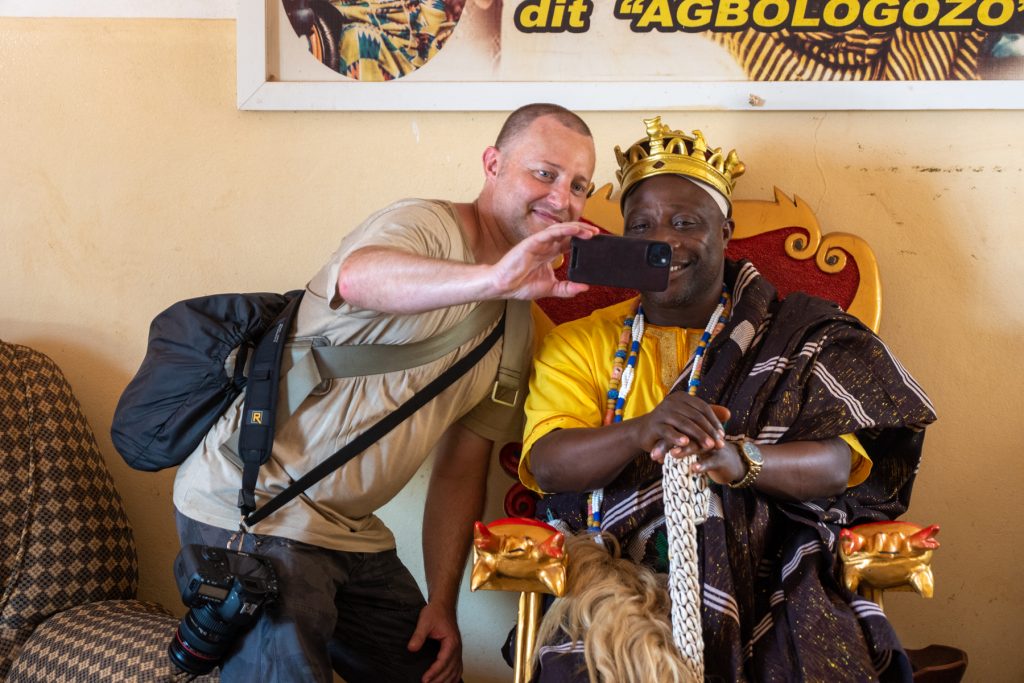
James enjoying a brief selfie moment with King Agassa, the highest figure of voodoo in the world (image by Inger Vandyke)
I was trying to tell my group that they should try never to take an experience like this for granted, that a private audience with the highest figure in voodoo was a bit like meeting the pope. Normally you cannot get anywhere near him. When he is travelling he is trapped in a cavalcade of many cars. In public he is normally surrounded by crowds of adoring followers.
After finally tearing ourselves away from the warm reception we received from the King’s family, we went down to a nearby lake to enjoy lunch on a jetty over the water.
Gambada
That afternoon we attended a private ceremony of Gambada, the voodoo celebration of love. This was our first introduction to the voodoo concept of trance. After the ceremonial Gambada statues were brought out (and given cigarettes to smoke!), several dancers fell into the dance area covered in Kaolin powder. They were in trance as they prepared for the ceremony. After they effectively emerge from this wild state, each of them twirled around to the beat of many drums to celebrate love, happiness and finding a partner in voodoo.
Continuing until sunset we all enjoyed photographing the dancers, musicians and crowd before we retreated to our beautiful hotel on the beach for dinner, once again by the sea.
The Voodoo Festival
Festival day saw us attend this amazing annual cultural event in a stadium right next to the beach at Grand Popo. As the actual festival itself didn’t start until late morning, we decided to visit a couple of the traditional fishing villages on the beach near to where the festival was going to start. These pretty villages of thatched palm huts, gigantic coconut palms and wooden fishing pirogues are quickly becoming a thing of the past in West Africa as the entire region tries to ‘modernise’ sadly at the demise of these villages. We enjoyed a walk along the beach past a few boats and we finished our visit with a photography session of around 25 or so fishermen trying to haul a gigantic net from the sea by hand.
We finally drove down to join the festival and after parking our bus, we joined the throngs of festival attendees all heading to this event, the biggest of its type in Benin each year.
To our surprise we were all invited to sit in the private audience with King Agassa in the shade. This was a wonderful and unexpected invitation which we all enjoyed doing in between occasional wanderings to photograph the festival goers and events.
It was great to just photograph the crowd here and while it was on we got our first taste of some of the more prominent ceremonies that happen in voodoo including Koku and Zangbeto, with some of the latter actually arriving on boats from across a nearby lake.
Benin has literally hundreds of kings and many of these were in attendance at the festival, alongside beautifully decorated voodoo adept women with their white togas and many strands of colourful beads.
Although we couldn’t get anywhere near him, we all felt very honoured that King Agassa decided to share his private audience with us and we even got to sit with the current Miss Benin!. We became so caught up in all of the festival proceedings that we actually bypassed having lunch. We grabbed some local fruit to eat in the van as we drove out to a location where we would see our final ceremony of the day – a private ceremony of Zangbeto.
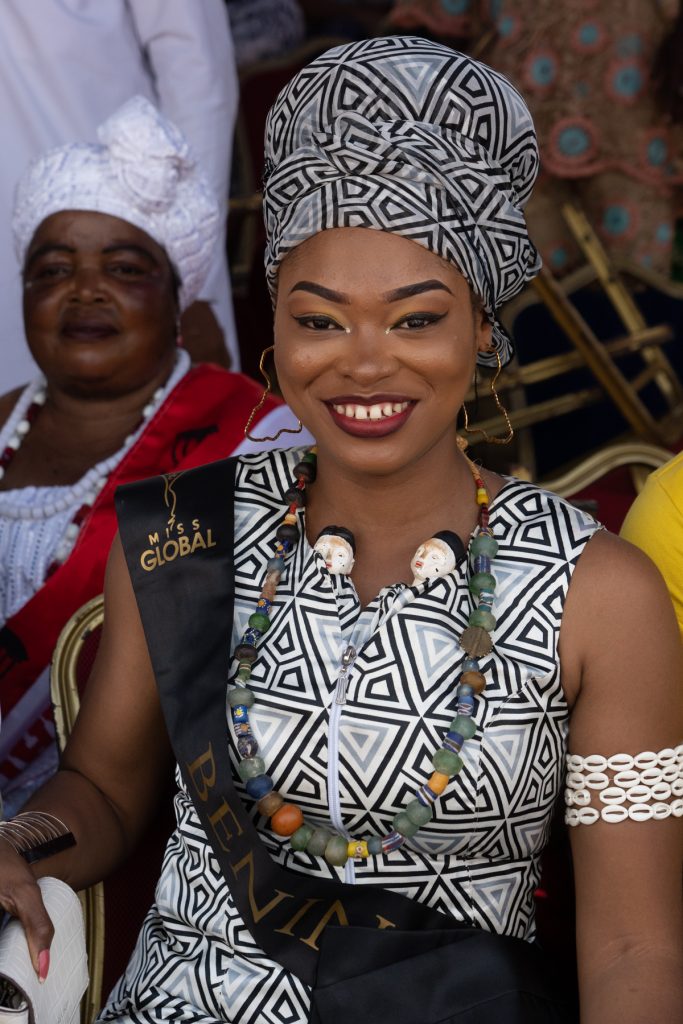
Miss Benin at the annual voodoo festival! (image by Inger Vandyke)
Egungun – The First Encounter
As we were driving we went through a small village where we spotted two wandering Egunguns, the ancestral spirit masked dancers that originate in Yoruba culture. We stopped the car spontaneously and got out to ask if they would mind us taking photos. Thankfully they said yes. The hardest part of encounters like these is working out quickly what might be a good place to take photos. On this occasion we found an iron monger’s workshop so we took some Egungun photos with a somewhat industrial background which seemed to oddly complement them in the end.
Zangbeto
We ended our day with a private ceremony of the incredible Zangbetos, the voodoo guardians of the night. I organised for this ceremony to take place in a really beautiful open area lined with traditional African homes and mud walls, but abutting a neighbouring sacred forest. We walked in the short distance and waited as the musicians all assembled. These waits are commonplace in West Africa (everything works on African time) but they give us the chance to mingle with the local people and grab some candid shots until the main event begins.
Spinning and flipping Zangbetos at a remote village in Benin
Finally the Zangbetos. Of all the masked dances we visit in Benin, the Zangbeto has always been a personal favourite of mine. To me they look like giant conical street sweepers but when they are flipped you can’t see any humans under them.
In the end we were visited by five Zangbetos during this ceremony and one was repeatedly flipped to reveal the following – a bowl of water with leaves that the guardian baptised us with, a tiny spinning Zangbeto, a small moving figurine and finally a tiny crocodile creature that was fed balls of rice! By the time we left the light was getting bad for photos but I think none of us really wanted this one to end. It was amazing!
Feeding the ‘spirit human’ after he twirled a Zangbeto at our ceremony
The following day we enjoyed what we thought was going to be a slightly quieter time until we chanced upon two very unexpected ceremonies.
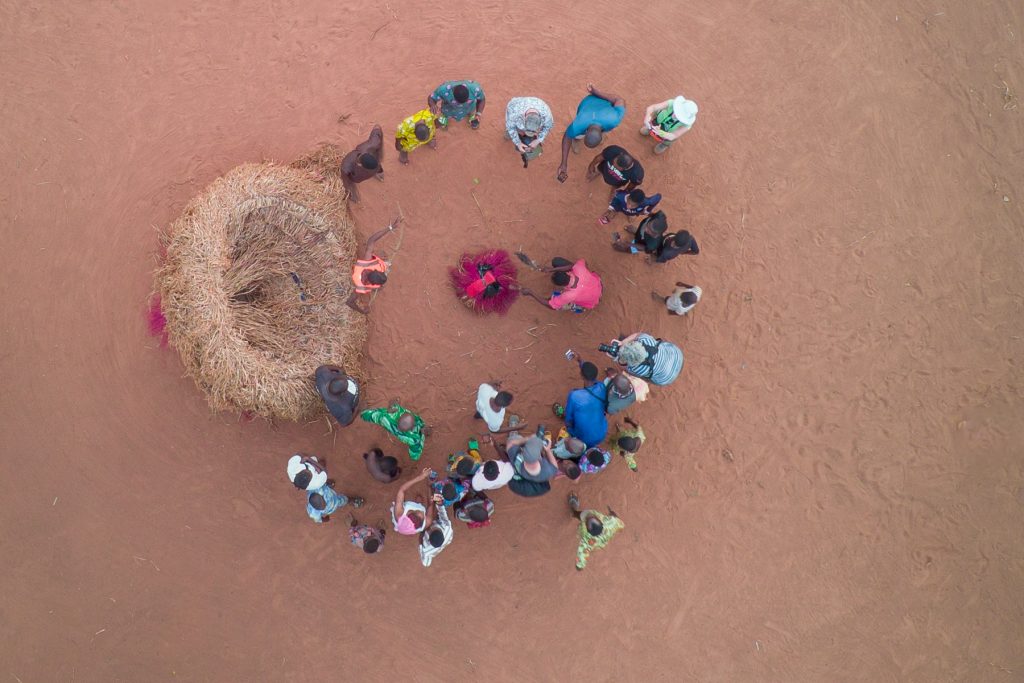
Our group gather around a flipped Zangbeto to take photos (image by Inger Vandyke)
Ouidah
Our day began with a journey to the former capital of slavery in Benin, Ouidah. It was here we began our day by visiting the otherworldly Python Temple where we caught up with a friend of mine who is the youngest of four generations of python handlers in a tradition that sees pet pythons released onto the streets of Ouidah at night. If they turn up at your residence this is considered very good luck and you must keep the python before returning it alive to the temple the following morning.
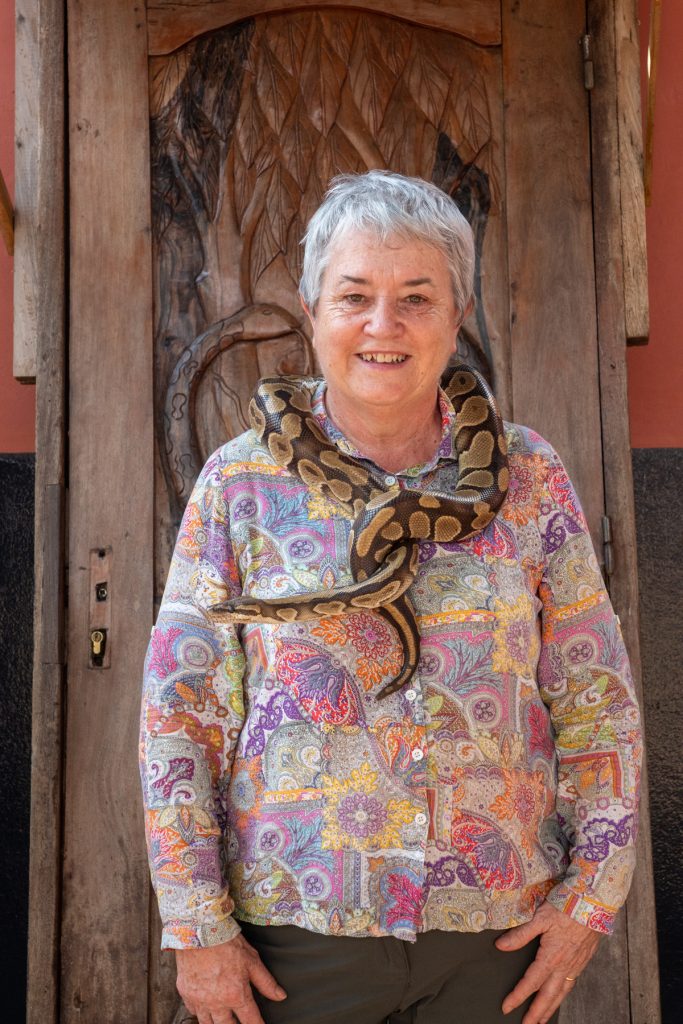
Ann braves the chance to hold one of Ouidah’s pythons at the python temple (image by Inger Vandyke)
We then took a short tour to visit the newly refurbished former trading market for slaves, the dark place, or Zomaï as it is called in the local language, where slaves were held, a mass burial site, the tree of forgetfulness (where slaves were forced to circumambulate to forget their past) , the slavery monument of a large wood carving depicting the story of slavery in Benin and finally we drove the former slave road a brief visit to the Portal of No Return monument which was under renovation.
It is all very confronting and sad to visit these monuments in Benin but I’ve always felt it is good to see the African version of this very dark era in our history and the careful way in which it is portrayed to the outside world.
After our tour of the slavery monuments we enjoyed a wonderful light lunch in a renovated former Afro-Brazilian house which had been turned into a restaurant and art gallery.
Ganvié
The afternoon saw us leaving Ouidah for the bustling ferry stop so we could reach the lake community of Ganvié. While our gear was being unpacked from the car and loaded onto wooden pirogues, a couple of us had a chance to fly drones over this stunning location for aerial photography.
Then we all boarded canoes and off we went to Ganvié, the ‘Venice of West Africa’. Suddenly the heat of the city gave way to the cooler climes of the lake and mesmerised we joined throngs of canoes making their way to and from this remarkable city. En-route we stopped to photograph fishermen throwing their cast nets into the lake to fish.
Arriving at our rustic overnight homestay we checked in and boarded smaller, paddle-driven canoes to take a tour of Ganvié at sunset. It was here that we came across two very unexpected and random ceremonies. In all of my visits to Ganvié, I have never been ashore on one of the island communities and to visit one while two ceremonies were in play was an absolute highlight of our visit!
Tron
The first ceremony we encountered was the Voodoo celebration of happiness called Tron. This involved some elaborately dressed attendees being blessed by a lady who was covered in kaolin powder to help her procure the spirits and bless the audience with happiness.
Egungun (The Second Encounter)
It was while we were watching and photographing Tron that one of my guests told me she had seen some Egunguns hiding in a building. We actually asked if we could see them and what followed was another full blown celebration of Egunguns who happily posed for our photos in between terrorising the assembled crowds of local kids!
When we finally left we went back to our home stay in time for sunset and dinner of lake fish with cold beer
The following morning a heavy harmattan hit Ganvié and the entire area was shrouded in a thick fog as a result. It was actually a surreal way to see this famous place and watch the main canal traffic of canoes ply their way through the mist at dawn.
We left after breakfast and had a chance to photograph the fishermen on our way back to Cotonou. Again we had a short time to do some drone photography of the local fish market before we boarded the bus and drove out to the former capital of Benin, Porto Novo. We enjoyed a brief stop and some street photography around the city’s ancient, colourful mosque before heading to a local restaurant for lunch.
Holi People
We spent the afternoon visiting three lovely and remote communities of Holi people as we head eastward towards the border of Nigeria. The Holi people are a heavily scarred and tattooed culture of the larger Yoruba people and, accompanied by numerous hand holding children, we wandered around their villages watching a welcome ceremony by one of the local head men, and photographing daily life in these pretty villages while meeting and photographing some of the older tattooed women and younger scarred people.
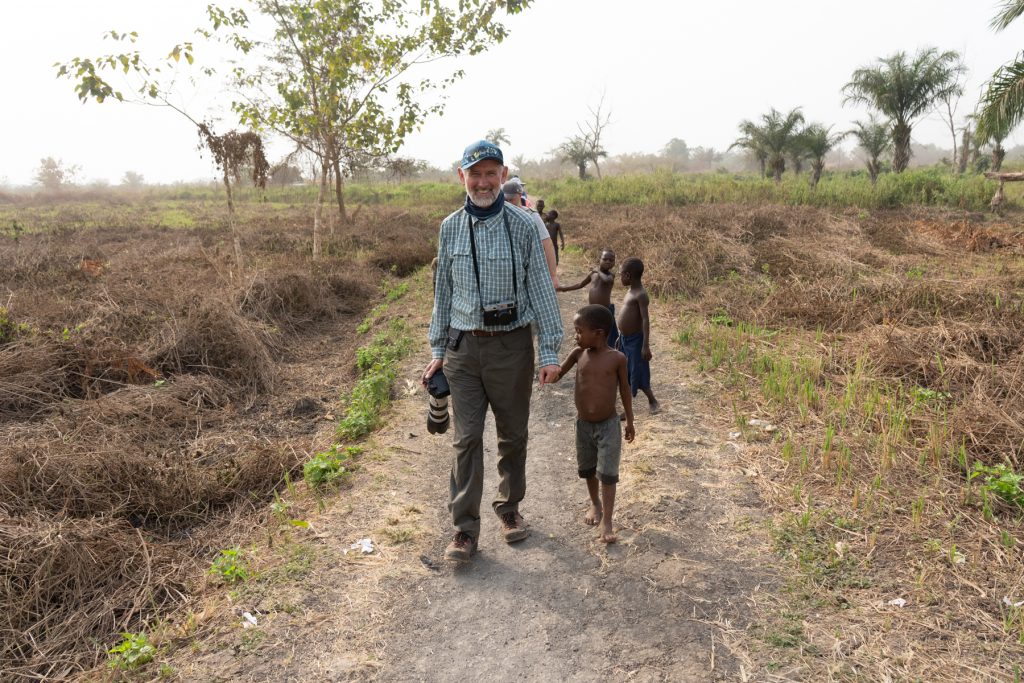
John walks into a Holi village with his newly appointed local guide (image by Inger Vandyke)
By the time we reached the eastern city of Cové it was dark.
By this point in the tour we were very close to the border of Benin and Nigeria and we spent our first morning in this area visiting a remote fishing community on a freshwater lake near Nigeria. It is always lovely to visit this community as it is so remote that the people are not so used to visitors or photographers. We travelled out in poled canoes and when we arrived we found two men carving a new wooden fishing canoe. We then wandered around the labyrinth of back streets photographing the local residents mending nets, drying and smoking fish and visiting the local school.
Guèlèdè
We returned to Cové for lunch and a break to escape the heat of the day. Towards the mid-afternoon we drove out to a village of warm and friendly Mahé people where we expected to see a ceremony of Guèlèdè. As we waited for the ceremony to begin we were flooded by the local kids, all fascinated by our visit and hoping to have their photos taken. We met up with an elderly Mahé lady friend of mine who dressed up in her finest clothes for us to take photos of her and her family.
Finally we were summoned to the ceremony arena as our private Guèlèdè masked dancer had arrived for us to take portrait shots. What an amazing start to the ceremony this was!

Rimma and one of the incredible masked dancers of Guèlèdè (image by Inger Vandyke)
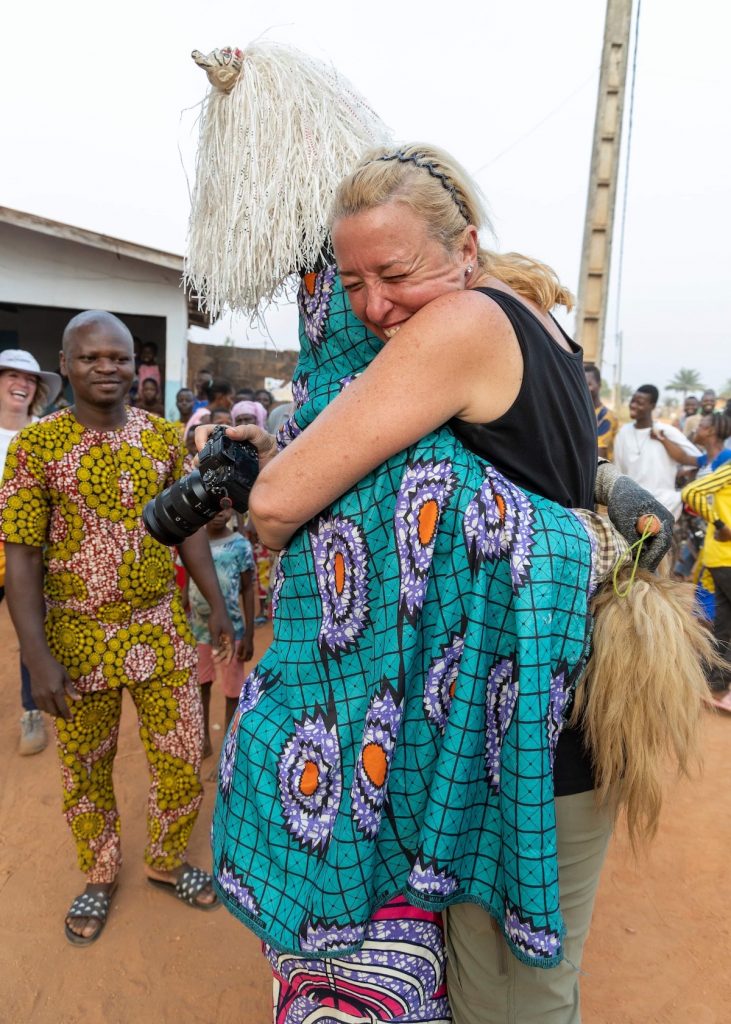
Catching up with a Guèlèdè friend (image by Rimma Aronov)
Guèlèdè is the ultimate celebration of the feminine divinity so we were truly blessed to photograph this masked dancer with two of the local small children nearby before he joined the other dancers of the ceremony.
As usual Guèlèdè was fantastic and we met quite a number of different dancers all being blessed by ceremony officials and joining us for photos.
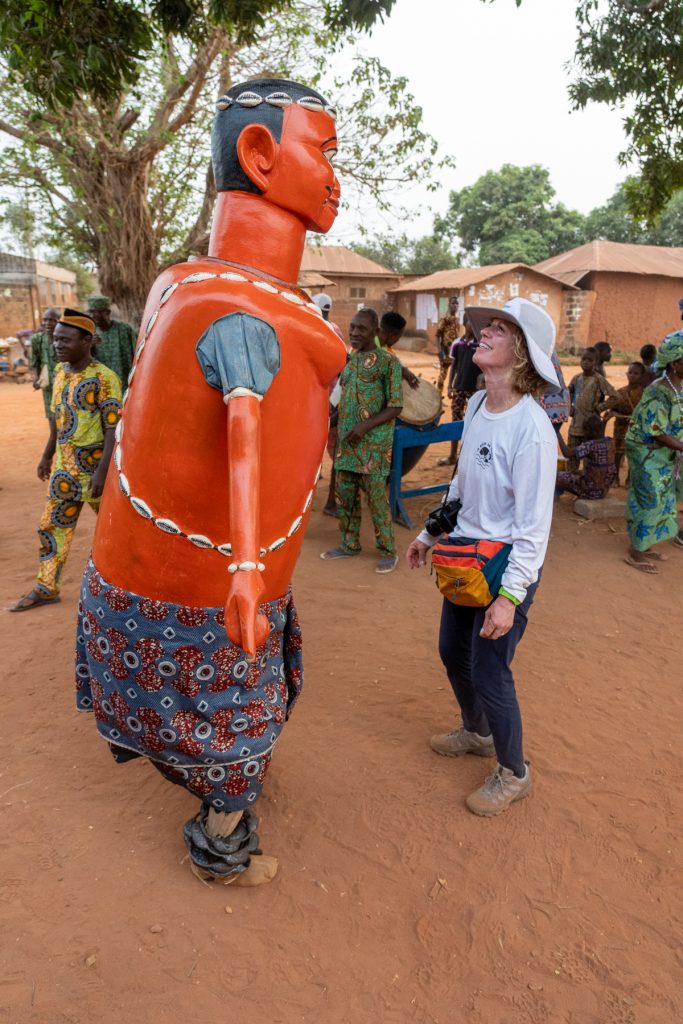
Janice makes eye contact with a gigantic Guèlèdè dancer (image by Inger Vandyke)
As it concluded we heard that another ceremony was taking place nearby so we walked over to check it out.
Atigali
The voodoo healing ceremony of Atigali was taking place in a neighbouring suburb square so we went along to watch a number of women and girls wearing striped skirts and covered in kaolin powder all performing a number of healing ceremonies to people who had mental and physical ailments.
As we missed the usual large orange masked dancers at Guèlèdè, some of us returned to see them instead of staying at Atigali, while others stayed on at Atigali.
Towards sunset we enjoyed these two huge masked dancers doing a small private display for us and hugging us as the day concluded.
Batonu Horsemen
The next morning we packed up our bags and drove north to the city of Parakou. Arriving in time for lunch and checking in to our hotel, we then went off to enjoy an afternoon with the incredible Batonu, or Bariba, horsemen of the city.
By chance we found out that an initiation ceremony was going to happen for young riders in this obscure but fascinating community so we went to one of the head riders’ houses in order to watch him prepare his horse. Amusingly we watched him dress up his youngest son as a future horseman and took photos of it all before we slowly drove through the streets of the city, following him on horseback to the ceremony.
Once we arrived we joined a small assembling crowd of local people all waiting for the horsemen to arrive. What followed was probably one of the wildest afternoons of our entire tour with around fifteen horsemen all racing and dancing their horses through the streets in front of us.
In all of my time in Benin, I had never seen such a wild display from these guys and all of us were enthralled.
Finally we were allowed briefly into the compound where the initiation would take place, but sadly we were not allowed to photograph the initiation ceremony itself.
What an incredible afternoon! Most of us were covered in dust and grit from the vivid horseriding activity and all of us were left completely mesmerised by what we had seen.
We drove further north the following day. After realising we were going to be in the Taneka area too late for photos, I decided we should continue north to Naititingou, rather than risk an unbearable walk in the hills during the heat of midday.
Waaba
Arriving at our hotel in Naititingou in time for lunch and some impromptu shopping of wax cloth, we all took a short rest before being visited by a beautiful group of the local Waaba women who came to see us and dance.
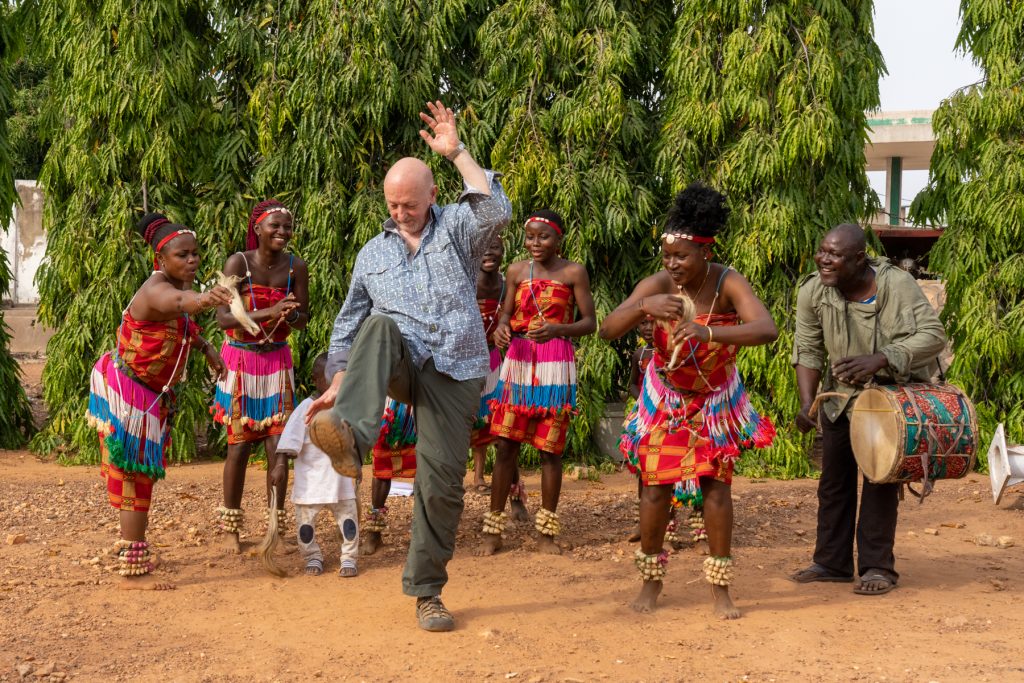
Dave joins in the dancing of Waaba people near Naititingou (image by Inger Vandyke)
Normally I wouldn’t put on a ceremony like this on my tours but these women came to see us to dance and say thank you for helping a little boy of their group to have life-changing surgery to correct the congenital bow-leg condition he was born with.
Last year we went to an offsite ceremony of the same Waaba women. During it we noticed that one of the little boys had terrible bow-legs. We asked if there was anything we could do to help him and what transpired was a life-changing experience for all of us. Between my guests and I we raised enough money for him to have surgery and for his family to stay with him for three months while he underwent rehabilitation for his new legs. By the time we visited this year, his leg braces were off and he was walking like any normal little boy.
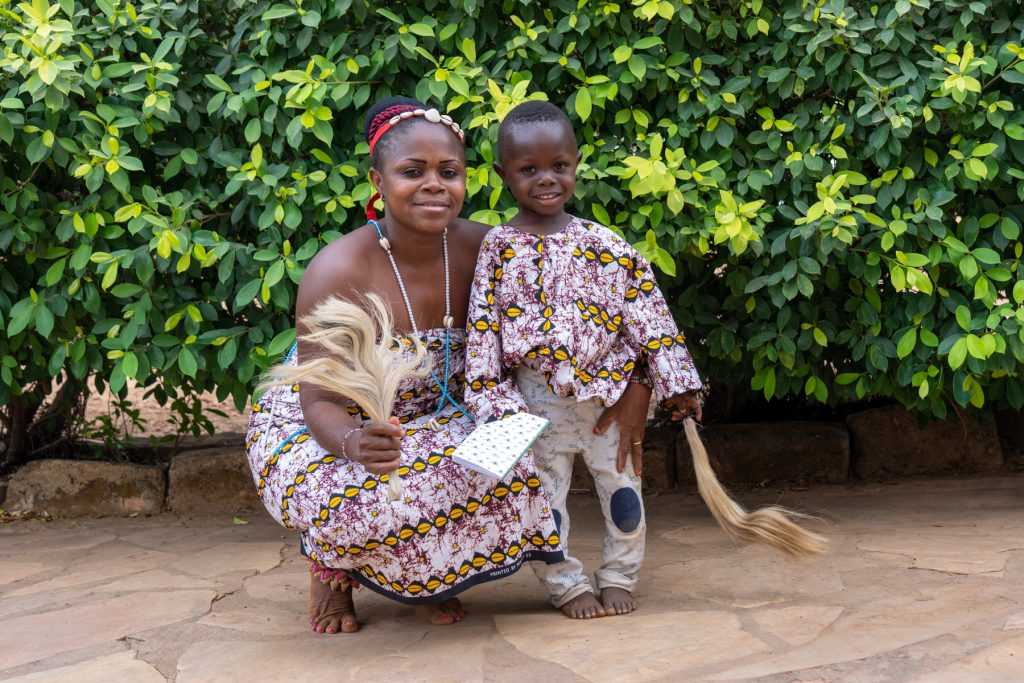
Antoine and his mum in northern Benin (image by Inger Vandyke)
I was overjoyed to see him again. What an amazing journey he had been through over this past year. He had grown up so much!
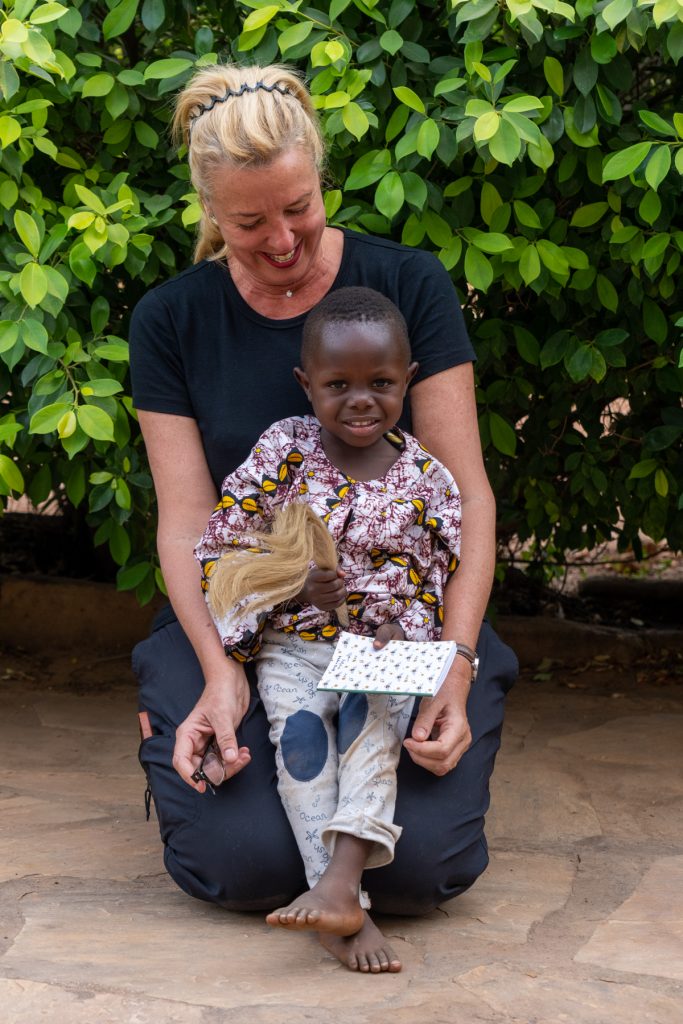
Inger with little Antoine, almost a year after his surgery (image by Inger Vandyke)
So we were all happy to enjoy this unplanned ceremony to say thank you to us for helping him. Audience participation was high on our tasks during it and each of us got up to try and dance with the locals which was hilarious.
Fulani Wedding
I had originally planned to head out to some local Tata houses, the earthly sculpted homes of the region’s Otamari people, for sunset. On the way out to them we got sidetracked by another impromptu ceremony when we saw a group of Borgu Fulani people assembled on the side of the road to celebrate a local wedding.
We stopped the car and asked if we might take some photographs of the people we saw. After all the Borgu Fulanis, with their intricately tattooed faces and traditional royal blue clothing, are some of the most beautiful Fulanis in Africa. We made a brief visit to their nearby village to take some photographs of the wedding crowd before moving on to visit our first Tata as the sun went down.
Otamari
The Otamari people of northern Benin and Togo are the creators of an incredible vernacular African architectural style of Tatas. These ancient structures are all handcrafted using local materials, and each of them is unique in terms of decoration. While they all loosely follow the same internal structure, their beauty and their intrinsic connection to the wilderness of the Atacora mountains was the impetus behind them being included in the UNESCO World Heritage list in 2004.
During our first visit to one we were shown around by the beautifully scarred son of its owner so not only did we get to visit our first Tata but we also got to see the elegantly beautiful scarification of the Otamari people for the first time. We spent a little time here wandering around the local fields and learning a little about Otamari culture before we returned to our hotel at dusk.
Dikuntri
The next morning we went back out into the mountains to visit an ancient Tata to photograph the traditional initiation ceremony of Otamari girls called Dikuntri. A lively group of Otamari women performed this ceremony for us in front of the old Tata and they kindly allowed us to take portraits of them afterwards.
We then went off to sit in the shade of some gigantic mango trees to enjoy lunch at a friend’s restaurant. While we were dining a heavily decorated Otamari headman arrived and we were all taken aback by his amazing dress and appearance. We asked if we might be able to take photos of him and he invited us to his home Tata to do so after lunch.
After an amazing feast, we all boarded the bus to follow him out to his home. Sadly we got an issue with one of our bus wheels so we had to replace it on the way and we were a little late but we still managed to visit one of the most beautiful Tatas in the area while photographing the most elaborately decorated head man I’ve ever met in Benin!
Borgu Fulani People
Since we had already arranged a time, we then went off to meet a group of Fulani friends of mine who had decided to drive to a local village to meet us.
We met this community of people during my visit last year and we thoroughly enjoyed both the warmth of their hospitality and the incredible tattoo marks of their culture. Between that visit and the visit this year, the community sadly encountered trouble with a group of Islamists from Burkina Faso. One of the Fulani women was actually kidnapped by these men and held for ransom. When the family couldn’t pay it fast enough, they proceeded to torture her. This year, when we met her, I saw her scar and I cried. We had just transported her and her daughter on our bus to meet her community at a remote, unnamed village.
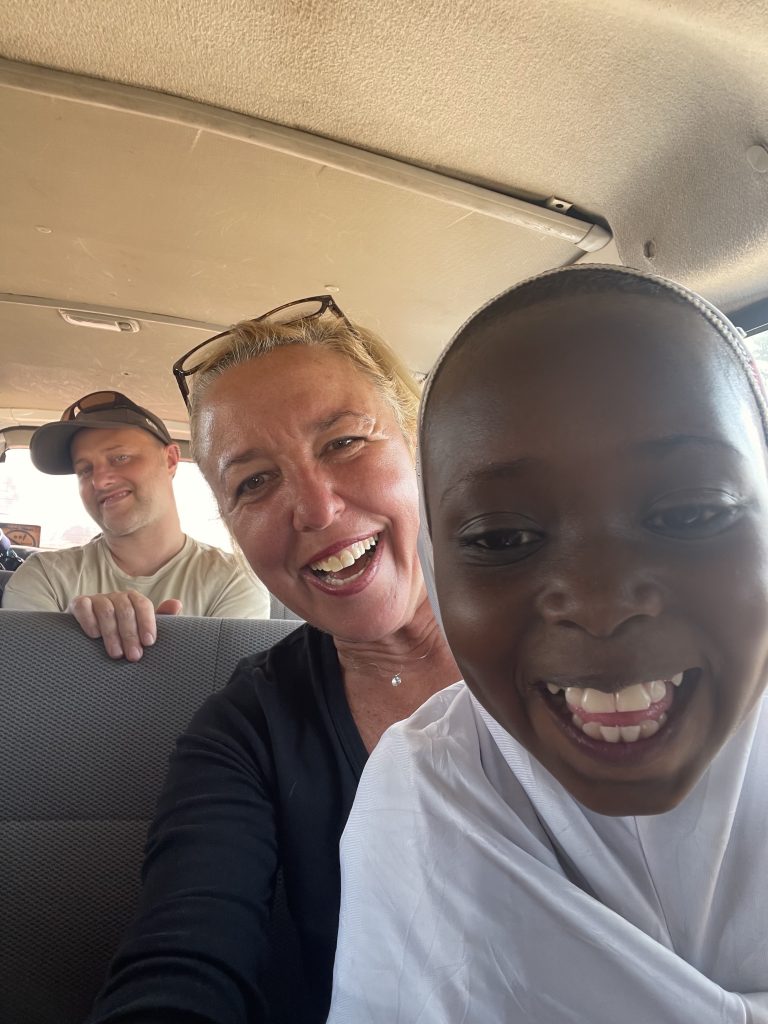
Selfie with a Fulani little girl. We gave her and her mum a lift from the market to a village (image by Inger Vandyke)
Looking at her scarred leg was a very poignant reminder of how these people are terrorised by Islamic fundamentalists.
This was the community where we had raised funds to build a water well. Sadly, that project is now on hold until these people can move to a safer place to live, where the well will be built for them and they will hopefully be able to live free from persecution.
During our visit with them, I also had a chance to give one of the women a copy of a book that she had appeared in through the Atlas of Humanity.
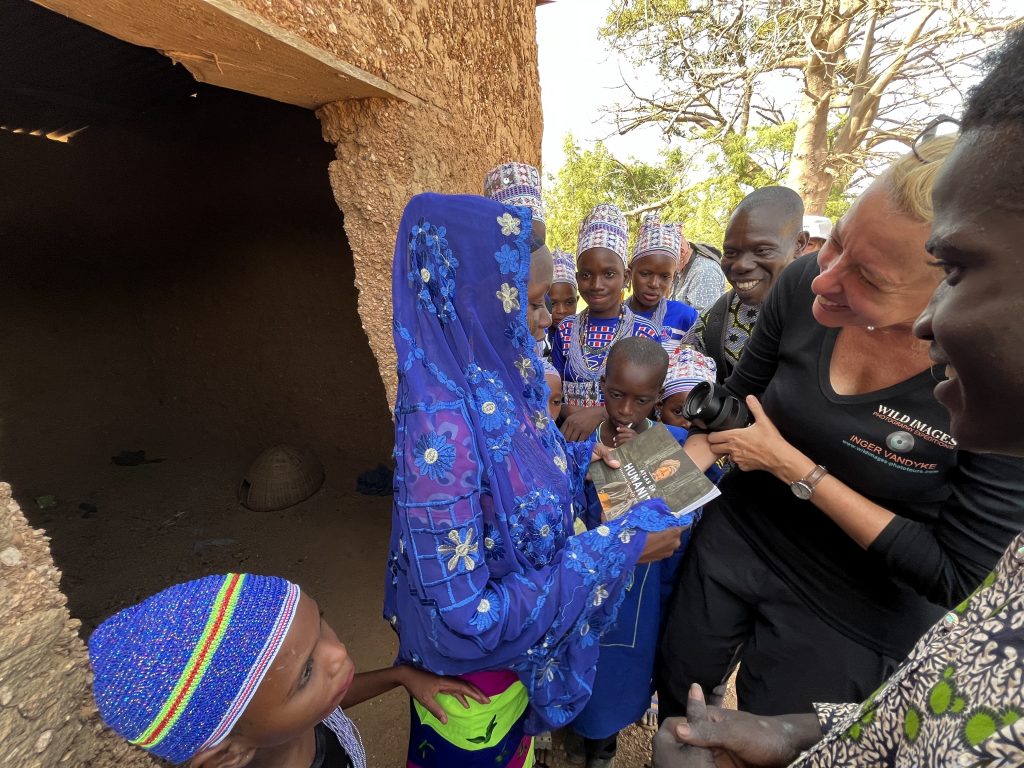
Inger presenting the Atlas of Humanity book to the Fulani lady she photographed for the exhibition (image by Inger Vandyke)
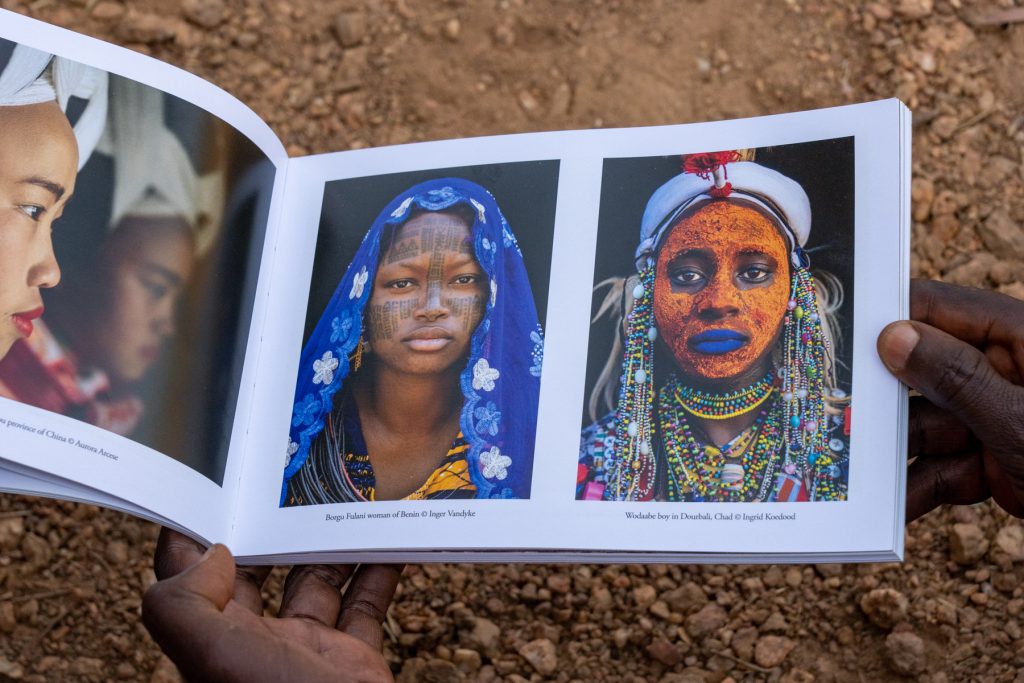
The Atlas of Humanity exhibition book, featuring a Fulani lady Inger photographed in Benin (image by Inger Vandyke)
As always it was hard to say goodbye to these people. I have a long affection for the Fulani people of Africa through a family tie. Thankfully I am in touch with this community regularly to see how they are.
Dikpantri
Later that afternoon we return to the morning Tata to see a ceremony of Dikpantri, or the passage from warriors to elders, in the Otamari people. This ceremony involved a number of young Otamari men dancing while wearing a grey ‘beard’ fashioned out of animal hair. It was a vivacious event that we were invited to join. Afterwards, we did some portrait photographs of the ceremony performers in the old Tata, which was beautiful.
That night we dined outside in the cool mountain air under a blanket of stars. Enthralled by the day, two of our group members also got up and performed their own ceremony of Northern Soul. What a fantastic way to end the day!
Taneka Funeral
Since we skipped the Taneka people on our way north, the next morning, we left Naititingou early to visit them on the way south.
Living in a village at the foothills of the Atacora mountains in northern Benin, the Taneka spiritual healers live in a rustic village on a rocky hillock. To reach them, you need to drive along a dirt road lined with cashew trees so we stopped on our way to their village, to try out our first cashew fruits, which were delicious.
Arriving at the base of the walk to the Taneka people, we were met by our guide who led us up a rocky path to the village. It was here we met the first of our Taneka spiritual healers, an elderly gent smoking a long pipe.
As we meandered the rocky paths between different Taneka compounds, we found out that a gathering was taking place for a Taneka funeral. We stopped briefly to photograph a second spiritual healer before we went off to join a large group of Taneka people gathering to attend a funeral. On our arrival at this gathering, we stopped to photograph a beautiful woman with very detailed Taneka scarification on her face while we waited for the ceremony to start.
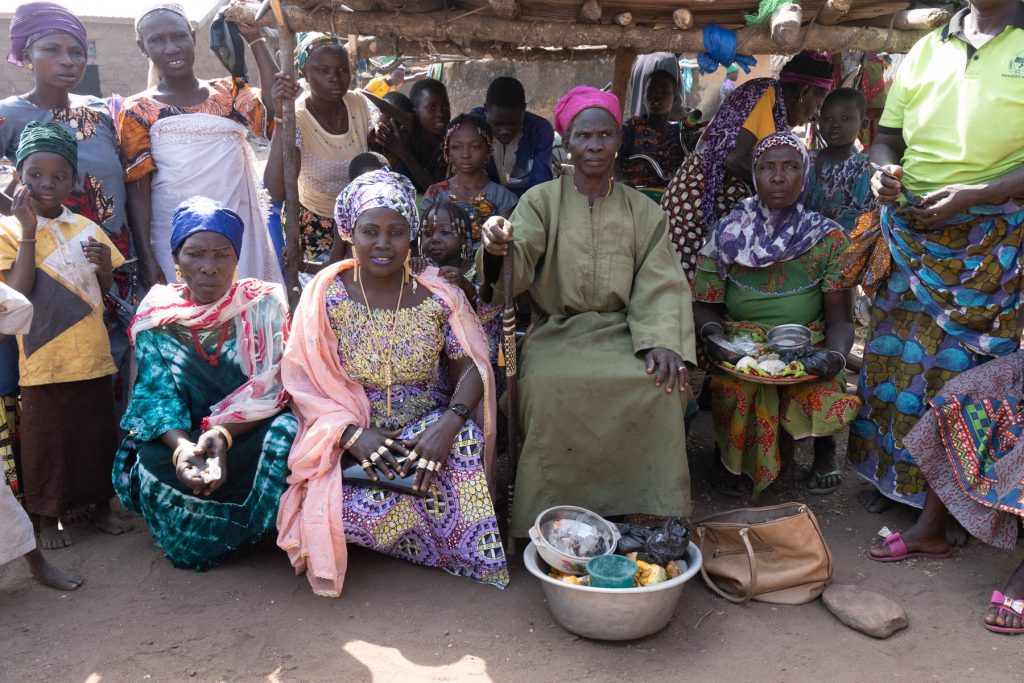
A Taneka matriarch overseas the arrival of attendees at a funeral (image by Inger Vandyke)
In the end, the heat was building and the light was getting harsh so we decided to leave the ceremony before it started.
Instead of attending the ceremony, we met up with another spiritual healer and his wife who kindly let us photograph him in his family compound. He was the healer of fertility and responsible for women’s health in the Taneka people. When he found out that one of our guests was the mother of twins he actually offered to give her a special Taneka blessing which was a fantastic way to end our visit to these very special people.
Dankoli Fetish
After we descended from the Atacora, we went off to enjoy a delicious lunch and ginger juice at a restaurant run by a delightful family of Algerian people. The rest was a welcome break before the long journey south towards the city of Dassa.
Shortly before we reached Dassa, we made a brief stop at the famous Dankoli Fetish, the largest forest shrine of voodoo in the world.
This confronting place of animal sacrifice is not very photogenic but it is one of those places that you need to visit in Benin as it is right on the side of the road and hard to miss.
We arrived at Dassa to enjoy a dinner beside the pool of our hotel.
Sakpata
The next day we began our tour with an incredible ceremony of Sakpata. This was to be our fifteenth ceremony of the tour and it was probably one of the wildest ceremonies I’ve ever seen in Benin.
Sakpata is a healing ceremony performed to heal people with ailments. The god of Sakpata actually lives in the earth so we arrived to find a group of drummers making their way to the shade of a mango tree. The dancers then arrived and they were led by a beautiful woman dressed like a voodoo adept with her white robes and colourful beads.
A series of athletic dances followed where a group of young men and women twirled and somersaulted before us. The highlight came when one male dancer appeared carrying a live chicken in his mouth! He paraded around in front of us seeking offerings, and at one point, he grabbed my second camera and walked around with it while carrying the live chicken in his mouth! Eventually, he put my camera down and took the chicken over to the musicians, where it was sacrificed by him biting the chicken’s head off. Wow!
The athletic dancers of Sakpata
The dancing continued, and as the ceremony came to an end, the adept lady who was the healer, performed a song and lay down on the earth to procure the god of Sakpata while she was singing. All this activity eventually died down, and the ceremony concluded, but we were all left speechless by what we had seen! It was one of the most memorable ceremonies we would witness during our trip!
We then went to Abomey, where we checked in at our hotel and then enjoyed a lunch of local Fulani cheeses and Beninese food while we shopped for some traditional masks. That afternoon we decided to take a small rest at the hotel and do some running around in the city before we all met up for a lovely dinner at the hotel that evening.
Abomey Palaces and Modern Art Gallery
A quieter morning transpired as we spent some time visiting the palaces of the Kingdom of Dahomey in Abomey. We went on a guided trip to the palace complex and enjoyed a small amount of photography in the palace courtyard where we met weavers of the local Abomey cloth and did a small amount of souvenir shopping.
Leaving the palaces we visited a lovely remote gallery of modern Beninese Art which was both fascinating and beautiful.
We enjoyed a buffet lunch of spicy Beninese food at a local restaurant in the city before we drove out towards Cové for two spectacular ceremonies to finish the day.
Egungun (The Main Event)
Our first ceremony was the actual private ceremony of Egungun which we had planned to do as part of the tour all along. Although we had seen two smaller ceremonies during the trip already, this main event did not disappoint as we photographed these spectacular dancers close to a temple where they were worshipped. We all enjoyed an incredible performance of around seven Egunguns, some of whom came over to us to try and frighten us, in between their vivid twirling dances.
At the end of their display I arranged for a few of them to walk with us to a nearby ‘forest’ of palms so we could photograph them in a more natural surrounding, other than a village. Egunguns, after all, are supposed to live in a sacred forest, so we all enjoyed photographing them in this beautiful setting as the afternoon light softened.
After the portaits of Egunguns concluded we joined them in a walk back to their temple, where the ceremony concluded.
Guèlèdè – The Fire Spitter
As the sun began to set on another spectacular day we ended up visiting the home of a local mask carver who created the incredible Guèlèdè masks for ceremonies. We spent a little time photographing this family home with his carvings that were underway. While we were there, we actually saw him preparing one dancer to perform for us by placing a bowl of burning embers on his head.
He then ignited the fire on this dancer’s head and the dancer performed for us with his flaming mask! It was great that this happened close to the sunset as the fire seemed more illuminated by the encroaching night. At one point the dancer grabbed some of the embers from his flaming bowl and threw them on the ground around us, forcing me to warn some of my group members with a “watch out!”. Sometimes when you are photographing events like this it isn’t easy to see the impending danger you might be in. This event was yet another unexpected high point of our tour. All of us were enthralled!
Vodunsi
Leaving Abomey, we drove out to a very remote village near the Togolese border of Benin, to visit a tiny community of Vodunsi, or voodoo brides. This community rarely sees visits from outsiders or photographers, so we assembled under the shade of a tree. What followed was a very special celebration performed by beautifully made-up Vodunsi of singing and dancing to show off what they had learned. The head Vodunsi was a beautiful girl who was already a mother to a young baby boy, and she even breastfed him during this amazing yet intimate ceremony.
After it had concluded, we lingered for a while to take portraits and community shots of the individual Vodunsi and their families before we were farewell with so much warmth and friendliness that none of us wanted to leave!
Koku
We headed off to our afternoon ceremony of Koku, one of the most spectacular ceremonies you can witness in voodoo – the display of power and strength.
Arriving at a small village near a Koku legba, we joined the village onlookers as we waited for the heavily scarred Koku dancers to arrive. Koku dancers by their very nature are often heavily scarred from the cutting of previous ceremonies and although ours was a largely simulated one it was still a private performance and left us all a bit gobsmacked.
During the ceremony we watched the preparation of the arena, dancers visiting the legba, dancers having alcohol spat over them as a blessing and we also watched them covering their bodies in the trademark kaolin powder mixed with palm oil to form a yellow paste. Koku is the voodoo display of strength and over the years I’ve watched these I’ve seen dancers falling on prickly pear cactus, pushing knives down their own throats and cutting themselves with blades. This one featured simulated tongue, chest and ear cutting, with one dancer trying to push a knife through his own navel. At one point one of the dancers smashed a tequila bottle over his own head! It was all very wild and a memorable ceremony to witness.
What a frenetic and powerful way to end the last full day of our tour!
Twins
On our last day of the trip, we attended a small but fascinating and somewhat quieter ceremony to celebrate the culture of twin children in Beninese society. This tiny shrine devoted to twins is looked after by a high priestess who, every day, looks after a series of dolls that have been carved to look like the twins that have been lost in her family. She feeds, bathes and dresses them daily in a cultural quirk that is very unique to Benin.
The countries of Benin and Nigeria have some of the highest rates of multiple births in the world. If a pair of twins dies at child birth, the parents will carry dolls of their deceased children around with them until they die. These tiny dolls are looked after like their own children. If only one twin dies then the sibling will carry one doll around as its brother or sister until that twin dies. During the course of our tour we had seen quite a number of women carrying these lovely dolls with them in the street and at ceremonies so it was wonderful to finish our tour with a ceremony that truly celebrates this unique tradition.
After a brief stop in the coastal town of Ouidah, we then drove on to Cotonou where we enjoyed our last sunset dinner on the beach.
What a fantastic way to end our fun, action-packed trip to Benin.
On a very personal side note – as the tour leader of this trip I think we laid down a very high bench mark with the 2023 tour to Benin. We originally mandated around 13 private ceremonies on this tour. In the end we saw no less than 20! It was hard for any of us to pin down a highlight but if I had to mention one, it would have to be a close tie between our awesome driver/guide team and also one tremendously talented, humble and friendly group of photographers who joined me on this visual spectacular. I’m already looking forward to going back in 2024!
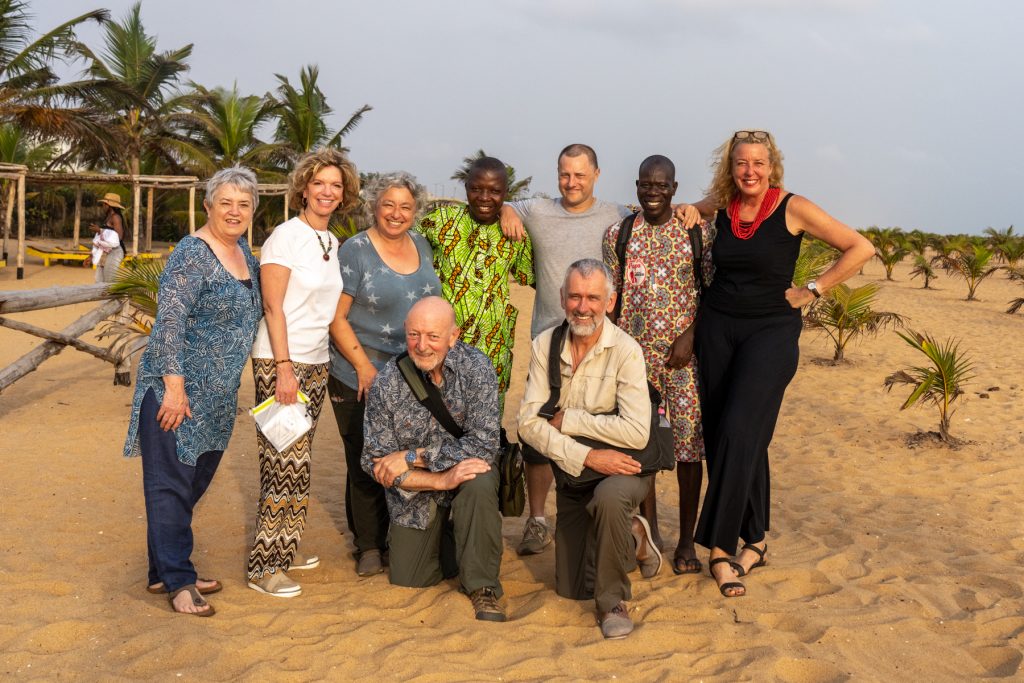
What a fantastic group of people to share our action packed tour of Benin. On our last night we enjoyed a sunset dinner on the beach (image by Inger Vandyke)







































































































































